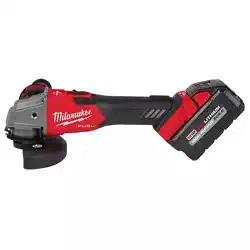Loading ...
Loading ...
Loading ...

7
Sanding Disc Selection
Use sanding discs and accessories that are:
• correct size as written on tool’s nameplate.
• rated at or above the RPM listed on the tool’s name-
plate.
• correct accessory, wheel type and grit for the job.
Select the correct type of sanding disc for your job.
Generally, use 24 or 36 grit for heavy stock removal;
50, 60, or 80 grit for medium stock removal and 120
grit for nishing. Always begin with a coarse grit, us-
ing successively ner grits to obtain the desired nish.
•Aluminum Oxide: For fast cutting, general purpose
discs for most metal jobs. Best for cold-rolled steel,
stainless steel or metals requiring tough, fast cutting,
long lasting abrasives.
•Aluminum Zirconia Bi-Cut: Unique grit pattern is
arranged in clusters for faster stock removal and
cleaning. Ideal for removing paint from cars, boats,
etc. without clogging.
•Ceramic: Lasts up to 3 times longer than Aluminum
Oxide Discs. For general metal working. Ideal for
tough jobs.
Installing Backing Pad and Sanding Discs
1. Remove the battery pack. WARNING! Always
remove battery pack before changing or removing
accessories.
2. Wipe the accessories, disc nut, and spindle to
remove dust and debris. Inspect the parts for dam-
age. Replace if needed. Use only MILWAUKEE
mounting hardware designed for your tool.
3. Slip backing pad onto spindle with at side away
from gear case.
4. Place sanding disc on backing pad and secure
assembly to spindle with disc nut.
Spindle
Backing pad
Disc nut
Sanding disc
5. Press in the spindle lock button while turning ange
nut clockwise. Tighten securely.
6. To remove backing pad and sanding disc, remove
the battery pack and reverse the procedure.
Installing/Removing/Cleaning
the Dust Screen
Using the dust screen will increase the performance
and extend the life of the tool.
1. To attach the dust screen, snap the screen over
the tool’s handle.
2. To remove the dust screen, insert a at screw-
driver into the notch at the top of the dust screen
and pry away from the tool.
3. To clean the dust screen, tap against a hard sur-
face, or blow clean with compressed air.
OPERATION
WARNING
To reduce the risk of injury, always
wear proper eye protection marked
to comply with ANSI Z87.1.
When working in dusty situations, wear appro-
priate respiratory protection or use an OSHA
compliant dust extraction solution.
Never grind without proper safety equipment.
Controlled Start
The controlled start feature reduces the torque reac-
tion "jerk" when the trigger is pulled.
Electric Brake
(Models with RAPIDSTOP™)
The electric brake engages when the switch is re-
leased, causing the wheel to stop within seconds.
There may be a delay between the time the switch is
released and when the brake engages. Occasionally
the brake may miss completely. If the brake misses
frequently, have the tool serviced by an authorized
MILWAUKEE service facility. Make sure the tool
comes to a complete stop before laying it down.
WARNING
Always hold the tool rmly with
both hands using the handles
provided before and during grinding.
Paddle Switch Operation
(2880-20)
To start the tool, grasp the handle and side handle
rmly. Push the lock-o button forward and squeeze
the paddle switch.
To stop the tool, release the paddle switch. Make
sure the tool comes to a complete stop before laying
down the tool.
Slide Switch Operation
(2881-20)
To start the tool, grasp the handle and side handle
rmly and slide the switch to ON.
To stop the tool, release the switch. Make sure the tool
comes to a complete stop before laying down the tool.
To lock-on the switch, slide the switch to ON and
press down on the front of the switch. To stop the
tool, press and release the switch. Make sure the tool
comes to a complete stop before laying down the tool.
General Operation
1. If you have just installed an accessory or are be-
ginning a period of work, test the wheel by letting it
spin for one minute before applying it to the work-
piece. WARNING! Never use a accessory that has
been dropped. Out-of-balance or damaged acces-
sories can mar workpiece, damage the tool, and
cause stress that may cause accessory failure.
2. Use a clamp, vise or other practical means to hold
the workpiece, freeing both hands to control the
tool.
3. WARNING! Hold tool securely with both hands.
Start the tool.
NOTE: If the battery is inserted when the tool is
ON, the tool will not run. Turn the tool OFF, then
back ON to begin work.
4. Allow accessory to come to full speed before
beginning work.
5. Control pressure and surface contact between ac-
cessory and workpiece. WARNING! Never bang
accessory onto work.Too much pressure causes
accessory failure or slows speed.
6. When nished, turn o the tool and make sure it
comes to a complete stop before laying it down.
Loading ...
Loading ...
Loading ...
